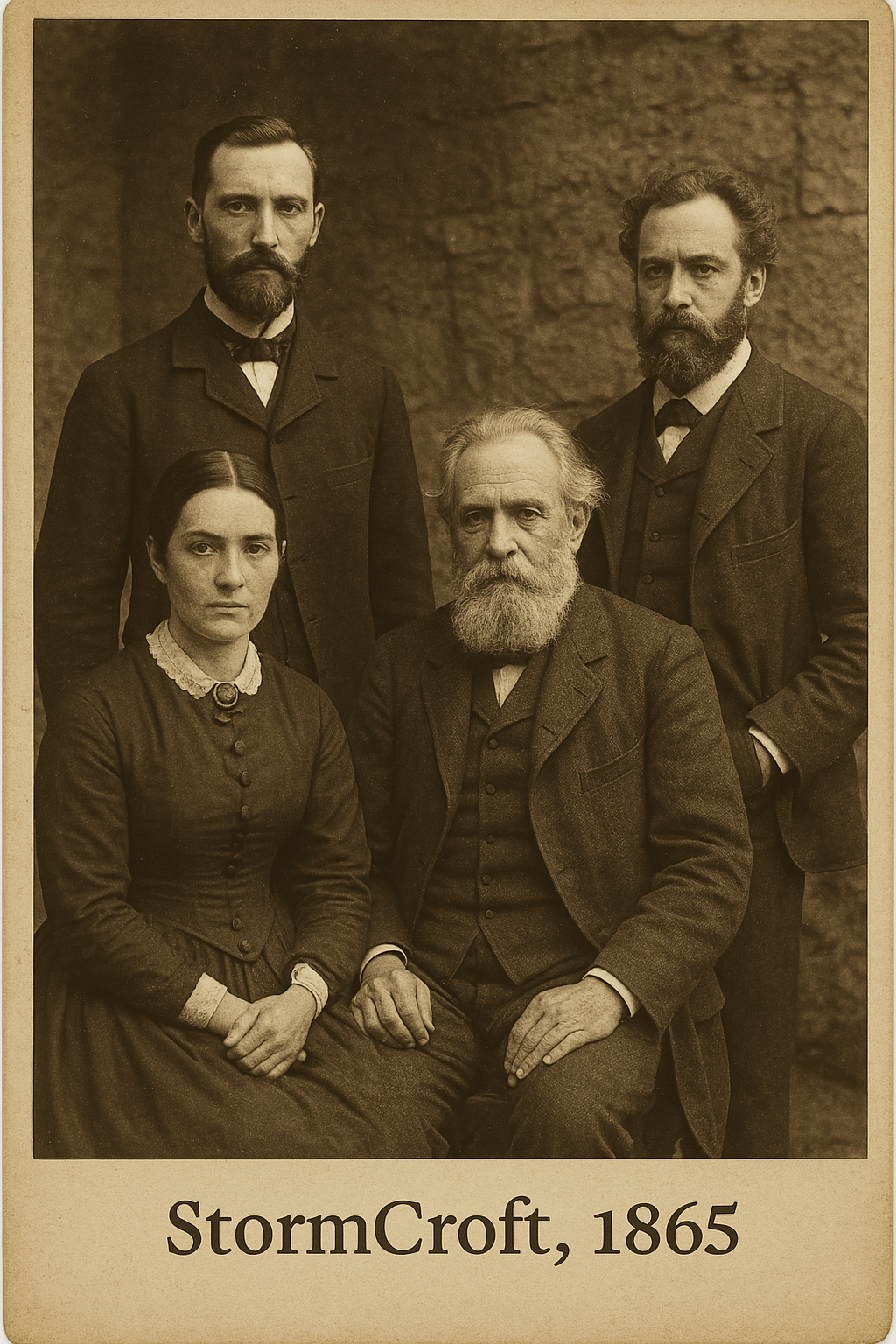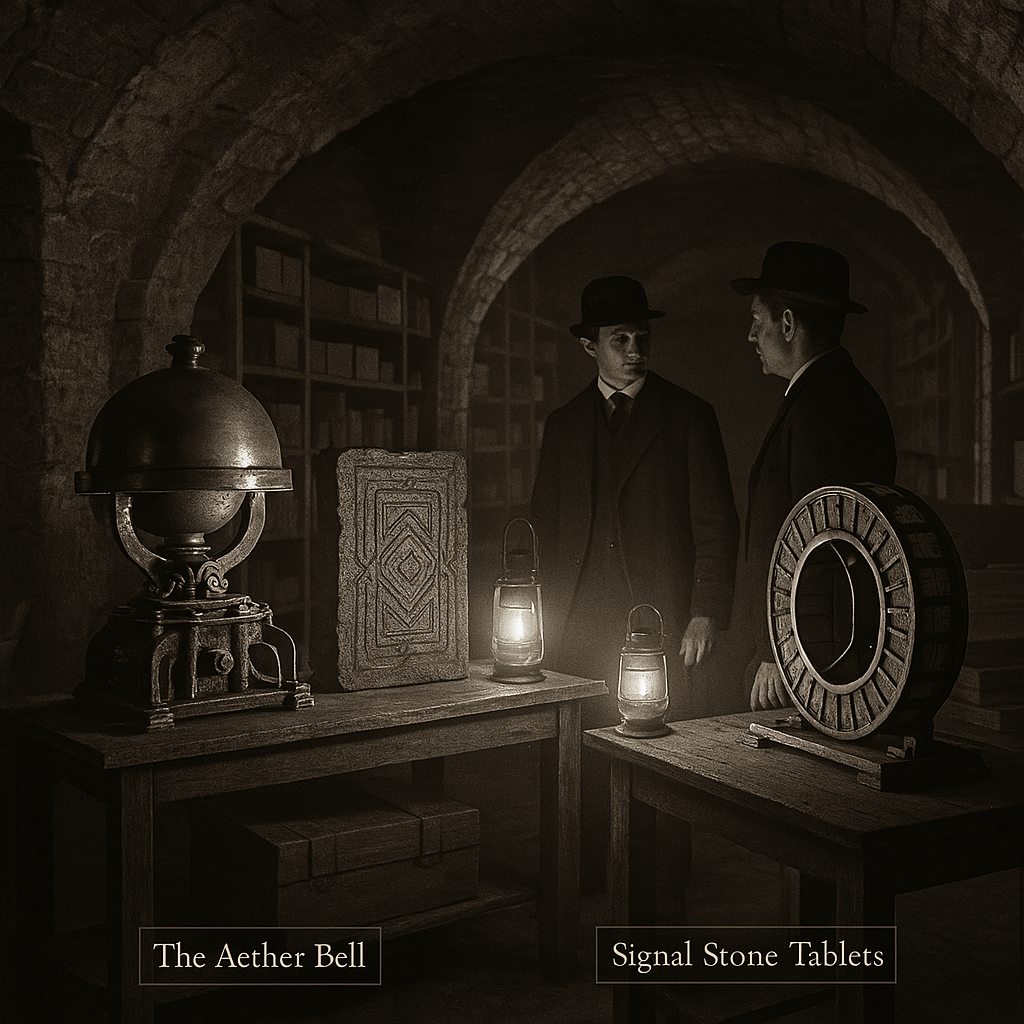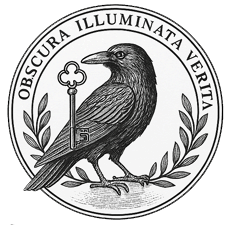“Some companies are started. This one was summoned.” – Marginalia found in Box 3B, StormCroft Archive Room North (sealed)
The First Formation: StormCroft, 1865
Official histories record the birth of StormCroft Systems Ltd. in 1978. That is technically true — but historically incorrect. What would become StormCroft had already been formed, met, divided, and partially buried over a century earlier.
In 1865, at a stone manor near Dartmoor, a circle of British engineers, occult naturalists, and electromagnetic theorists gathered. They called themselves the StormCroft Initiative. Their mission: to discover whether human memory could be stored — not in the mind, but in air, metal, and time.

Names (left to right in the image):
Dr. Abram Finch – seated, left
Neuro-anatomist and dream-resonance theorist. Wrote the first recorded notes on “cross-thought aether harmonics.”
Octavius Wren – standing, left
Engineer and constructor of the original Loop Coil chamber beneath Dartmoor. Known for his precise silence and mechanical blueprints written in mirror text.
Dr. Lydia Stormcroft (née Glass) – seated, right
Visionary physicist and founder. Authored the lost paper “Signal as Memory.” Her presence here is the earliest known photograph of a British woman leading a theoretical physics circle.
Wilber R. Dart – standing, right
Railway signalman, telegraph technician, and time-slip obsessive. The only founder not officially recorded as deceased.
Photograph recovered from a sealed wooden container marked “Echo Provenance | Not To Be Released.” First seen publicly in 2025.
The Founders
Dr. Lydia Stormcroft (née Glass) — 1832–1910
A physicist, linguist, and aether theorist. Lydia studied magnetic fields in birds and theorised that space held memory like flesh holds scars. She coined “signal intelligence” in 1863. Died in total silence; body remained warm for four days.
Octavius Wren — 1819–1890
Royal Engineer and inventor of the failed “morse mirror” system. Believed impulse could influence perception remotely. Funded and constructed the first Loop Coil beneath Dartmoor. Vanished after placing a sealed lead box under the estate.
Dr. Abram Finch — 1821–1874
Expelled Cambridge neuro-anatomist. Worked on dream resonance and “Echo Tables” for thought transmission. Died mid-sentence while writing: “We are not the ones speaking.”
Wilber R. Dart — 1814–Unknown
Railway signalman obsessed with telegraph time shifts. Designed the “Offset Conductor,” believed to influence early CroftNet designs. Disappeared during a tunnel test; only gloves found.
The Early Years (1865–1900)
StormCroft functioned as a sealed hypothesis — a secret theory etched in coils, whispers, and handwound brass. Among their devices:
- The Aether Bell — to echo sound signals not yet spoken
- Signal Stone Tablets — etched frequency patterns found in 1981
- The Quiet Loop — a machine built to “store silence for future use”
The First Collapse (1901–1923)
The Initiative vanished by 1901. In 1922, GWR tunnel workers uncovered a brass hatch: “STORMCROFT SYSTEMS ACCESS LINE – MAINTAIN LOOP INTEGRITY.” In 1923, records note delays linked to “frequency clearance” from non-existent departments.
The Return (1948–1984)
Post-war, the government quietly reopened the estate. Records were purged. In 1978, StormCroft was re-registered. In 1983, the LG Oscillator reactivated itself. Logged: “unexpected temporal bleed, potentially communicative.”
The First Machines: Early StormCroft Devices (1865–1871)
“They weren’t inventing. They were remembering things we hadn’t built yet.”
– From the sealed 1869 notes of Lydia Stormcroft
Before CroftNet. Before the SC-13 interface. Before The Silence. There were three machines — hand-forged, brass-bound, and tucked beneath stone and secrecy. Together, they formed the trinity upon which the rest of StormCroft’s legacy rests. These were not tools of communication. They were thresholds. Invitations. Mechanisms of speculation too early for their time, and too dangerous for ours.

This black-and-white photograph, dated to late 1890, captures a pivotal moment in StormCroft’s early history — the unintentional rediscovery of its three original experimental devices: The Aether Bell, Signal Stone Tablets, and The Quiet Loop Mechanism Core.
The scene is lit by oil lamps, their glow caught in the reflective coils and brass curves of the machines. Dust hangs in the air, undisturbed for what appears to be decades. The arched stone vault shows signs of intentional sealing, including a partially collapsed entrance — suggesting the chamber had been deliberately hidden, not forgotten.
Three distinct objects can be seen:
At the rear centre: a domed apparatus suspended on rusted brass rings — unmistakably the Aether Bell, intact but partially oxidised.
On the left: a flat, granite slab with concentric symbols etched into its surface — one of the Signal Stone Tablets, later identified as Tablet II (“Stone Echo”).
To the right: coiled copper tubing and a rotating plinth base — remnants of the Quiet Loop’s mechanical interface, stored disassembled but oddly warm, according to recovery notes.
This article explores in detail the known construction, functions, and lingering mysteries of:
-
The Aether Bell
-
Signal Stone Tablets
-
The Quiet Loop
I. The Aether Bell (1865–1868)
“To hear is to follow. To follow is to be late.” – Octavius Wren
Origin:
Built between late 1865 and spring 1868 in the vaulted cellar of the original StormCroft estate, the Aether Bell was the first machine constructed by the founding four. Its design was largely theorised by Lydia Stormcroft, who believed that human intent produced a subtle electromagnetic resonance before action — that a sound, a thought, or a word began to exist before being expressed.
The Bell was meant to detect and echo these precognitive emissions. Its inner workings were tuned not to record, but to predict.
Construction:
-
A 6-foot cast brass dome suspended within a copper parabolic shell
-
Lined with fine silver wire and iron filings
-
Mounted upon a series of quartz-dampened gimbal plates
-
Encased in a Faraday-wrapped chamber with gaslight-only illumination
Inside, the Bell rang not with sound, but with vibration — a harmonic pulse faintly audible only when no one was speaking.
Observed Behaviour:
In controlled conditions, the Aether Bell began “vibrating” between 1.2 and 1.5 seconds before a subject made a vocal sound. In several cases, it predicted utterances that the speaker claimed to have thought but not said.
In later tests, it began to echo sentences no one had thought at all.
A notable entry from Finch’s log reads:
“We heard the Bell speak the phrase: ‘She must not return this time.’ No one in the room admitted to thinking it.”
After 1871, the Aether Bell was dismantled and its components hidden in four separate vaults.
One segment was recovered in 1984, found buried inside a lead box beneath a Tor cairn, still vibrating faintly.
II. Signal Stone Tablets (1867–1870)
“They carved into rock what we would later call binary.” – Fragment, Dartmoor Records Office (file redacted)
Appearance:
The Signal Stones are a series of six flat slabs of Dartmoor granite, each engraved with a repeating sequence of nested concentric lines, mirrored glyphs, and what has been interpreted as harmonic notation. They were discovered beneath the west wing during the 1981 renovations to the StormCroft site — perfectly preserved in dry clay.
Construction Theory:
Though assumed decorative at first, spectral analysis revealed that each etching matched a specific frequency range when mapped using audio-spectrum decoding. More astonishingly, these patterns mapped cleanly into early CroftNet waveform protocols — 112 years before that network was created.
Several historians now believe the tablets were:
-
Instructional objects, meant to “teach machines how to hear”
-
Memory transference plates, designed to record atmospheric shifts
-
Possibly non-human in origin, or influenced by something “remembered forward”
Each tablet hums when left in proximity to strong EM fields.
Key Discovery:
Tablet IV (code-named “Stone Echo”) emitted a measurable tone — a 3kHz sine wave — when placed on a metal table during a thunderstorm in 1982. The tone lasted 91 seconds. The room temperature dropped by 6.5°C.
Witnesses present reported intrusive dreams for a week following the event.
Tablet II was reportedly “lost in transit” during a private transfer to Exeter University in 1990. The driver was never located. The van was found abandoned, its inside walls scorched with the outline of the stone… but no stone.
III. The Quiet Loop (1869–1871)
“A room designed to store the absence of sound… but also the memory of who made it.”
– Lab Journal 7, unsigned
The Experiment:
The Quiet Loop was not merely a device, but a room-sized structure located directly beneath the manor’s original chapel floor. It was constructed by Octavius Wren with input from Lydia and Finch and was intended to test the concept of resonant stillness.
In short: could absolute silence be collected — and could that silence hold meaning?
Architecture:
-
Cylindrical stone room, 13 feet in diameter
-
Outer walls composed of layered lead, cork, and felt
-
Inner wall ringed with 27 small copper coils, each inscribed with Finch’s bioresonant script
-
A central plinth to hold an observer
Entry required complete decontamination — including removal of all memory-writing materials (paper, chalk, ink). Time spent in the Loop was not to exceed 12 minutes.
Results and Theories:
Subjects exiting the Loop reported:
-
Inability to recall their own names for several hours
-
Hearing echoes of voices they’d never met
-
Feeling as if time had “rewound” slightly
The most bizarre effect was recorded in Finch’s final entry:
“The loop has learned me. It waited until I was thinking of nothing, then replied with everything.”
After his death, the Loop was sealed. It was rediscovered in 1983 during emergency site works. Upon re-entry, sensors recorded a 0.02 Hz pulsing — matching an echo of Finch’s heartbeat, reconstructed from 1872 notes.
One investigator fainted upon entering the room. Her medical report read: “Reflex loss triggered by memory overload.”
The Loop is now flooded and deemed too unstable to excavate.
Summary
These machines were not technical devices. They were conceptual thresholds built in brass and stone. Whether they worked — or whether the founders believed they had worked — is almost irrelevant.
Because every trace they left behind still behaves as if it’s listening.
Two Men At The Discovery
The two men pictured are junior StormCroft maintenance employees:
- Nathaniel Bexley (left, kneeling) – A grounds technician responsible for drainage inspections. It was Bexley’s probing into what he believed to be “faulty runoff” that led to the partial collapse of the wall concealing the archive chamber.
- Harold Grayley (right, standing) – Newly hired document archivist, assigned to assist with mapping forgotten storage sections. Grayley would later claim he heard a “deep hum” coming from the Bell before anyone had touched it.
Neither man appears in later company records after 1892. Their disappearance was never investigated. A margin note from the 1937 personnel ledger simply reads:
“Bexley/Grayley – closed with chamber?”
This photograph was found in an envelope labelled “UNSCHEDULED ACCESS – CIRCLE BREACH 1890” and was first processed for digitisation in 2003.
Conclusion
StormCroft was not built. It was remembered into being. Its founders were not inventors. They were translators — scribes of something older trying to speak again.
“To study StormCroft is to engage in a dangerous archaeology of memory, machine, and meaning.”
